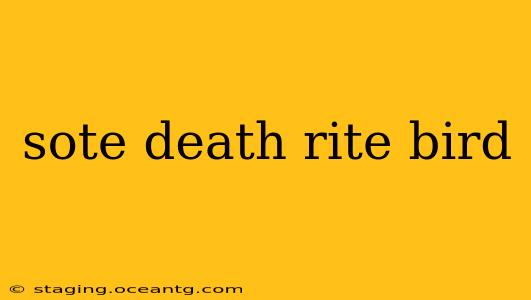The Sōtetsu Death Rite Bird: Unveiling the Mystery
The phrase "sōtetsu death rite bird" evokes an image of ancient ritual and symbolism. While there isn't a single, universally recognized bird specifically associated with a "sōtetsu death rite," the term hints at a fascinating intersection of Japanese culture, death rituals, and avian symbolism. Let's delve into the possible interpretations and unravel the mystery behind this intriguing phrase.
Understanding the Components:
-
Sōtetsu (蘇鉄): This refers to the cycad plant, a species known for its resilience and longevity. In Japanese culture, the sōtetsu often symbolizes perseverance and strength in the face of adversity. Its inclusion in a "death rite" context might suggest a connection to enduring memory or the cyclical nature of life and death.
-
Death Rite: Japanese death rituals, or shūsoku, are deeply rooted in Buddhist and Shinto traditions. These practices focus on honoring the deceased, ensuring a peaceful transition, and providing comfort to the bereaved. Different rites exist depending on religious beliefs and family customs.
-
Bird: Birds hold significant symbolic weight across various cultures, often representing freedom, the soul, messages from the afterlife, or spiritual intermediaries. Specific bird species can carry unique meanings within Japanese mythology and folklore.
What Birds Might Be Associated with Death Rites in Japan?
Several birds could be considered within the context of Japanese death rituals. However, no specific bird is definitively linked to a "sōtetsu death rite" without further clarification. Possible candidates, based on broader Japanese symbolism, include:
-
The Raven: Often associated with death and omens in many cultures, including Japan. Its appearance might be interpreted as a sign of transition or a message from the spirit world.
-
The White Heron: In some contexts, white birds, like the heron, symbolize purity and the soul's journey. Their presence at a funeral might be viewed as auspicious or symbolic of spiritual ascension.
-
The Crane: The crane is a sacred bird in Japan, often representing longevity and good fortune. While typically associated with positive symbolism, its appearance at a death rite could signify the continuation of the deceased's spirit or a peaceful passage.
Are there specific rituals involving cycads and birds?
While there's no widely documented ritual explicitly combining cycads and specific birds in a death rite, the symbolism of each element allows for diverse interpretations. The enduring nature of the sōtetsu alongside a bird's spiritual significance suggests a possible ritual focused on remembrance, the soul's journey, or the cyclical nature of life and death. Further research into specific regional customs or family traditions might reveal more detailed information.
What are other interpretations of "sotetsu death rite bird"?
The phrase might be metaphorical or symbolic rather than referring to a literal, established ritual. It could be used in literature, art, or storytelling to evoke a sense of loss, transition, or the enduring power of memory. The combination of seemingly disparate elements—the sturdy cycad, the transient bird, and the solemn death rite—creates a compelling image that invites contemplation on the themes of life, death, and the passage of time.
Could this phrase be related to a particular region or family tradition?
The possibility exists that "sōtetsu death rite bird" refers to a highly localized or family-specific tradition. Such practices might not be widely documented or known outside a specific community. Further investigation into regional folklore or genealogical research could potentially uncover more precise information.
Conclusion:
The "sōtetsu death rite bird" remains an intriguing and somewhat enigmatic phrase. While a definitive, singular answer is elusive, exploring the symbolism of each component reveals a rich tapestry of cultural meaning. The phrase itself prompts contemplation of life, death, and the intricate ways in which humans connect with nature and spirituality through ritual and symbolism. Further research into specific Japanese cultural practices and regional variations in death rites might illuminate this intriguing phrase further.
